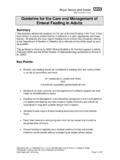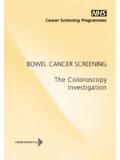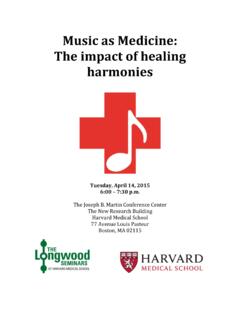Transcription of Secondary Intention Wound Healing
1 Page 1 of 2 Patient InformationReference Number: RDE 20 081 001(version date: September 2020) Secondary Intention Wound HealingWhat is Secondary Intention Healing ? Secondary Intention Healing means a Wound will be left open (rather than being stitched together) and left to heal by itself, filling in and closing up will mean you need regular dressings to the area for up to six weeks, but the time to full Healing depends on the size, depth and site of the Wound . Dressing changes may be carried out by your local practice nurse, or in some cases we will teach patients/relatives how to care for and redress the Wound at home.
2 Sometimes, a single running stitch is placed around the Wound to pull the edges closer to each other. This will normally be removed after 7-10 do I care for my Wound ? To help reduce the risk of bleeding, infection or poor Healing after your surgery, please: Rest and avoid strenuous activities straight after the procedure and for the next few days. A further period of reduced activity may also be sensible and will be discussed with you after your surgery. Where possible, raise the area treated. For example, if surgery was performed on your leg, limit the time spent standing still or sitting with your legs down.
3 Try to elevate the leg by lying down when you are not walking. We may suggest a compression stocking to speed up the Healing of leg wounds. If the Wound is on the head, avoid stooping / bending down too much. Consider using an extra pillow in bed. Avoid smoking or vaping if possible during the Healing process, as they reduce the blood supply to the area. What should I do if I feel any discomfort? It is normal for your Wound to feel sore and swollen after skin surgery, especially when the local anaesthetic wears off (in around one to three hours).
4 We suggest you take paracetamol when you get home, and then as required up to the maximum permitted dose. Do not take any aspirin or ibuprofen type medicines unless prescribed by your doctor, as they can cause bleeding. What should I do if my Wound bleeds? Your Wound may bleed after surgery. If this happens, Leave the dressing in place Apply firm continuous pressure over the dressing for 10-20 minutes and raise the area that is bleeding. If needed, apply another padded dressing on top. Once the bleeding has stopped, get the dressing changed for a clean one.
5 However, if you have heavy bleeding that does not stop, contact the Dermatology Unit on 01392 405516. After hours, please attend your local Emergency Department. Page 2 of 2 Reference Number: RDE 20 081 001(version date: September 2020)The Trust cannot accept any responsibility for the accuracy of the information given if the leaflet is not used by RD&E staff undertaking procedures at the RD&E hospitals. Royal Devon and Exeter NHS Foundation TrustDesigned by Graphics (Print & Design), RD&EWhat should I do if my Wound becomes infected?
6 As with any surgery, there is a risk of infection. If this occurs, it generally happens within 3-7 days after the operation. Signs of infection are Increase in pain Redness Heat Swelling Leakage of pus / blood stained fluid. If you notice these symptoms or you are concerned, please contact us on the number above for advice. When will I know if all of the cancer has been removed? It takes on average 4-5 weeks to have the results back in the department after your operation. We will write to you directly and send a copy of the letter to your GP.
7 If after six weeks you have not had a letter, please contact us on: 01392 405510 If your results show that your skin lesion was not completely removed, you may be asked to come back to the hospital for a further operation. Contact us: If you have any questions please contact the Dermatology Department, Level 1, Heavitree Hospital, on 01392 405516 and ask to speak with one of the nurses. If you need help with information, advice or support, you can contact the Royal Devon and Exeter Hospital Patient Advice and Liaison 402093 Useful websites for support / further information.









